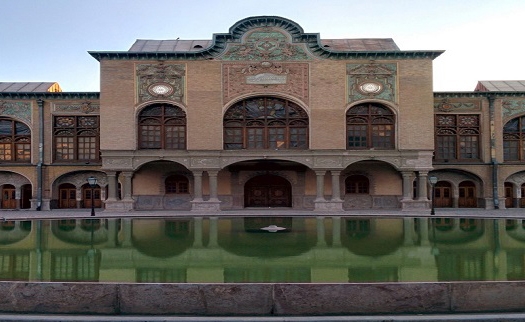Located in historical district of Tehran near Baharestan Square, Masoudieh Palace (Emarat-e Masoudieh) is one of the most beautiful palaces or historical houses from Qajar dynasty, comprised of a palace and surrounding houses.It was built in 1879 for the prince Mass’oud Mirza (Zell-e Soltan) — the son of Nasseredin
Shah and the governor of Isfahan — as his residence in the Capital. Spanning over an area of 5 hectares, the mansion was constructed in the middle of a garden with a total area of 4000 sq. meters consisted of Exterior Palace (Divankhaneh-our chosen building for 3D modeling), Interior Palace and other attachments. The main architect of its houses was Master Shaban Memarbashi. Have fun with along with caça niqueis gratis.
Being close to the Baharestan Plaza and Iran Parliament, Masoudieh Mansion has been home to many events that changed the history of the country, including a 75 year ownership by Ministry of Education and first national library and national museum of Iran on its territory. It was recorded as a Cultural Heritage in 1997. The mansion was fusilladed after an unsuccessful assassination of the Mohammadali Shah. It was one of the main gathering centers during the Persian Constitutional Revolution. But in recent year by doing a great revitalization work, it has turned into a nice garden with cafes and shops, attracting tourists and also residents of Tehran.
Beside of its political, cultural and historical importance, Masoudieh Mansion is a great example of aesthetic mixture of Iranian traditional and Modern-European Rococo style Architecture. The main reason of this collaboration is the increasing number of abroad travels of Nasseredin Shah and his successors and the effect of groups of Iranian students sent to Europe for higher education. It is consisted of various and innovative spaces representing transparency, lightness and openness developing Iranian architecture principles.
As you inter from the main gate into the garden, first thing being seen is the Divankhaneh palace framed by Plantains and Pine trees. It contains two of seven inscriptions of the whole collection with Persian “Nastaligh” font presenting Persian poets and tails from Quran. Brick, as the main material of its façade, juxtaposed by decorative gypsum on balconies, and stone on the lowest line attaching the floor, are the most dominant materials. Seven colored tile work of “Gholaman” and “Malazeman” designs delicately mix with floral forms to express formality. Gridded doors and “Orosi” windows with colored windows on back, accurately designed columns with Coriander leaves gypsum design and wooden fences add up a living spirit to the façade. These gridded windows have a great role in controlling the amount of daylight and air flow received by interior spaces. They also represent some of most important approaches in Ghajar architecture which are rooms with 2,3,and 5 doors-“do dari”,”se dari”,”panj dari”-adorning both inside and outside of the building.
Painted vases and painted pottery, the will to show landscape in the paintings, window decorations, slopped roof, and other neo-classic elements bring in the European architecture spirit. Symmetry and repetition of natural, floral and geometrical motifs are main characteristic of its decorative elements. Gypsum work on the façade is mainly for frames and marginal parts and are colored merely in these areas. In the term of tile work, beside of having framed independent areas on the façade, generally using violet, blue and green colors instead of typical colors of Iranian architecture that are red and yellow, they also cover the floor of balconies. Another important effect of European architecture, Specially the Rococo Style, was in the terms of motifs. Complicated real scenes and scenes from landscapes with delicate details took the place of Islamic simple and abstract motifs. All these facts and elements caused Masoudieh Mansion to be a real example of Iranian historical building with the spirit of more contemporary and modern architecture as a great collaboration with European one.

Comment (0)